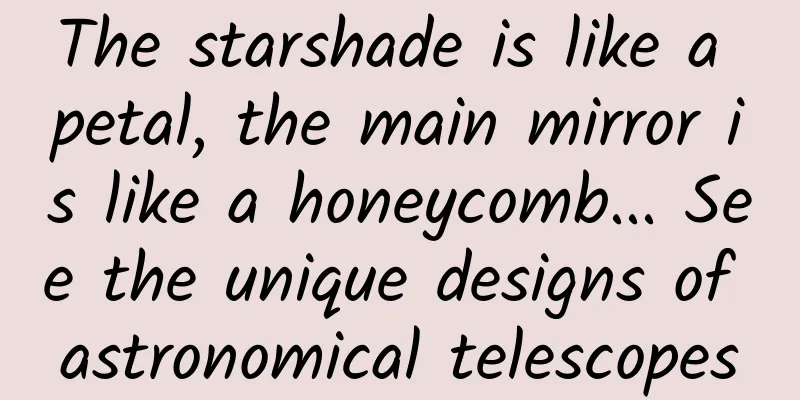The starshade is like a petal, the main mirror is like a honeycomb... See the unique designs of astronomical telescopes

|
On March 16, according to media reports, China plans to launch a new X-ray astronomical satellite, the Einstein Probe, by the end of 2023. It is expected to capture the first ray of light emitted by a supernova explosion, help search for and accurately locate the source of gravitational waves, and discover more distant and fainter celestial bodies in the universe, as well as those fleeting mysterious astronomical phenomena. It is reported that scientists were inspired by the unique focusing and imaging principles of lobster eyes and designed a special new X-ray telescope with an ultra-large observation field of view and higher detection sensitivity. In other words, this telescope can see a very wide range of universes while also being able to see the darker and more distant universe. Thanks to the use of the Lobster Eye telescope technology, the Einstein Probe satellite can conduct large-field, high-sensitivity, and rapid time-domain sky surveys in the soft X-ray band, which is currently little known. In fact, there are many telescopes as ingenious as the "Lobster Eye". They either travel through the universe or take root on the earth, contributing to the exploration of the mysteries of the universe. Guo Shoujing Telescope Optical fiber with mirrors, you can have the best of both worlds Image source: National Astronomical Observatory In the field of astronomical telescope design, there has always been a "you can't have your cake and eat it too" problem, which is the contradiction between large aperture and large field of view. Simply put, you can't have both "seeing far" and "seeing widely". The Large Sky Area Multi-Object Fiber Spectroscopic Telescope (LAMOST), also known as the Guo Shoujing Telescope, located in Xinglong County, Hebei Province, was originally developed to resolve the contradiction between the large aperture and large field of view of astronomical telescopes, paving the way for China to independently develop large-aperture telescopes. The overall structure of LAMOST is a Schmidt reflecting telescope. The light from the universe is first reflected by a flat primary mirror called MA to a spherical primary mirror called MB. The light is then focused on the focal plane of MB. On the focal plane, 4,000 optical fibers greet these rays, which accurately guide the light from different directions into the spectrometer. Because of these 4,000 optical fibers, LAMOST can theoretically observe up to 4,000 different stars at the same time. This is equivalent to obtaining a super large field of view. Therefore, LAMOST is not like a traditional optical telescope that can take beautiful photos of celestial bodies. It captures the spectrum of celestial bodies. In addition, active optical technology is the core key technology of LAMOST. The so-called active optics is to actively change the shape of the lens to overcome the influence of the deformation of the mirror itself caused by gravity, temperature and wind on the imaging, making the imaging clearer. It is difficult to make precise fine adjustments on a large mirror. The MA and MB main mirrors of LAMOST are composed of 24 and 37 small hexagonal mirrors respectively. The R&D team designed and installed actuators behind each lens. In addition to bearing the weight of the mirror, the more important function of these actuators is to adjust the shape of the mirror. Active optical technology can achieve real-time adjustment of small mirrors at the thousandth level through computer algorithms, allowing the small mirrors to deform according to observation needs and making each small mirror confocal. Thousands of force actuators control the small mirrors that make up the MA in real time to achieve the required shape, making the image clearer. LAMOST creatively applied multiple technologies to break through the bottleneck of large aperture and large field of view of telescopes, and also obtained a series of observation results. In March 2019, LAMOST's seven-year survey spectral data was officially released, containing 11.25 million spectra, which is about twice the total number of spectra released by other international survey projects. So far, LAMOST has become the world's first spectral survey project to obtain more than 10 million spectra. HabEx Telescope Or use "petals" to block the light of stars The HabEx telescope, or Habitable Exoplanet Observatory, is reportedly capable of directly photographing planets orbiting other stars. Its observation targets are all types of planets, from hot Jupiters to super-Earths, but its main mission is to observe Earth-like exoplanets. In other words, HabEx will try to detect signs of life on planets orbiting other stars. To achieve this, HabEx will need to block the light of stars so that it can detect dim planets around them. The first way HabEx will block the light of a star is to install a coronagraph, a tiny structure inside the telescope that blocks the light of a star, and the faint light of objects around the star will be imaged by the telescope's sensors. The telescope has a special deformable mirror that can be fine-tuned and adjusted until the faint planet comes into view. The second way the HabEx telescope blocks starlight is to use a starshade, a petal-shaped, football-field-sized shield located in front of the telescope that blocks the light from the star but allows light reflected from the planet to hit the telescope's instruments. In addition to its main mission of observing Earth-like exoplanets, the HabEx telescope will also be used for astrophysics research, such as observing the early universe and studying the chemical composition of massive stars before and after they explode as supernovas. China's Sky Eye Possessing a "retina" and a "pupil" Panoramic view of the "China Sky Eye" (taken during maintenance, drone photo). Photo by Xinhua News Agency reporter Ou Dongqu When talking about astronomical telescopes, I believe many people will think of the "big pot" located in the karst depression of Qiannan, Guizhou, my country - the Five-hundred-meter Aperture Spherical Radio Telescope (FAST). FAST, known as the "China Sky Eye", is currently the world's largest and most sensitive single-aperture radio telescope. The design of this "big pot" is different from the existing single-aperture radio telescopes in the world, mainly reflected in its "retina" and "pupil". "Retina" refers to the reflective surface, and "pupil" refers to the feed cabin. The "retina" of FAST is an active reflective surface composed of 4,500 reflective units. The cable net structure is the main supporting structure of the FAST active reflective surface. It can change its shape, sometimes becoming a sphere, sometimes a parabola. Just like a sailor pulling a cable to control the direction of a sail, the "pot" can be changed in direction by pulling the cable net, and the entire change of direction is calibrated by a laser positioning system. The design goal of the "retina" is to gather signals covering the range of 30 football fields in a space the size of a small pill, and monitor the weak radio signals in the universe as much as possible. The feed placed in the feed cabin is responsible for receiving cosmic signals - a speaker-like device that collects satellite signals. The suspended feed cabin is like a "pupil" looking at the universe. It weighs 30 tons and is suspended by 6 steel cables over 400 meters long. The range of movement can reach 200 meters. The displacement of each part of the cable net and the receiver in the feed cabin must be controlled at the millimeter level, so that FAST can work normally and "see" the mysteries of the universe. Since passing the national acceptance on January 11, 2020, FAST has achieved a series of important scientific results in frontier astronomical fields such as neutral hydrogen spectral line measurements of interstellar magnetic fields, fast radio bursts, and pulsar searches. James Webb Space Telescope Giant "honeycomb" mirror reveals secrets of the universe The James Webb Space Telescope deployed in space. Image credit: NASA Animator On December 25, 2021, the James Webb Space Telescope was launched. As the successor to the Hubble Space Telescope, the James Webb Space Telescope was highly anticipated. After several delays, it finally launched and achieved many breakthrough results, allowing people to see more distant deep space. These achievements are all thanks to a honeycomb-shaped "big mirror". The James Webb Space Telescope, which primarily observes in the infrared band, consists of optical and scientific instruments, a sunshield, and a support system called the "spacecraft bus", with a total weight of 6.2 tons. The optical module of the James Webb Space Telescope adopts a "three-mirror anastigmatism system": the infrared rays captured by the primary mirror are reflected by the secondary and tertiary mirrors, and then transmitted to the scientific instrument module by the fine steering mirror. The huge primary mirror with a diameter of 6.5 meters is the most eye-catching part of the James Webb Space Telescope. It is made up of 18 hexagonal lenses, and the light collection area is more than 5 times that of its "predecessor" Hubble Space Telescope. The secondary mirror is supported by three long arms extending from the front of the primary mirror, and the tertiary mirror and fine steering mirror are placed in the black "nose cone" protruding in the center of the primary mirror. To protect sensitive infrared signals from interference from space radiation, the James Webb Space Telescope needs to operate in a low-temperature environment of about -220 degrees Celsius. Its primary, secondary and tertiary mirrors are made of metal beryllium. This metal has a low density and relatively high hardness, and is not easy to shrink and deform at low temperatures. A layer of gold with a thickness of only 100 nanometers is sprayed on the surface of the mirror to optimize the mirror's infrared reflection performance. The integrated scientific instrument module is located on the back of the primary mirror and includes a near-infrared camera, a near-infrared spectrometer, a near-infrared imager, a seamless spectrometer, a mid-infrared instrument and other equipment. They will analyze and image the light collected by the James Webb Space Telescope. The huge kite-shaped sunshield is located below the primary mirror to protect the James Webb Space Telescope from radiation from the sun, the earth and the moon. The sunshield is nearly the size of a tennis court and is designed as a 5-layer film structure made of aluminum-coated polyimide. The outer layer closest to the sun is 0.050 mm thick, and the other layers are 0.025 mm thick. The sunshield separates the telescope into two cold and hot sides facing deep space and the sun, with a temperature difference of more than 300 degrees Celsius. Releasing the first batch of full-color deep space images, directly photographing an exoplanet for the first time, detecting the most distant galaxy to date, and penetrating layers of dust to detect the interior of galaxies... Since its launch, the James Webb Space Telescope has brought too many surprises to people. Today, it continues to drift in space, constantly exploring the mysteries of the early formation of the universe. Science and Technology Daily reporter Wei Yichen Source: Science and Technology Daily |
<<: Yesterday was February 30th, and today is February 1st. Did I travel through time?
>>: Warning! Pay attention to these things →
Recommend
Stop being emo! Beware of thyroid disease
Recently, #women with depression are more likely ...
Better-for-you 3D printing "living" ink is here, a new toolkit for synthetic biology
The concept of 3D printing technology has become ...
Detailed explanation of the logic of interactive advertising on Massive Engine
In 2021, one of the important keywords for China’...
iFlytek’s real dilemma: customers become rivals, technological advantages gradually disappear, and profitability track is uncertain
As former customers such as BAT have become rival...
The latest regulations on the 2022 epidemic: Is the city under lockdown? Can I come and go freely?
Following Shenzhen's stepped-up epidemic prev...
Common operating methods of information flow advertising!
Today we are going to talk about paying a high pr...
5G is not popular? Not true! That's just because cloud gaming has not arrived yet
Looking at the history of human communications, e...
A big pot of 10 H5 front-end frameworks
As a siege fighter who has been working on the fr...
Who helped Apple come back to life 20 years ago? It was Microsoft!
[[153644]] I'm afraid you will be surprised t...
How to fill in the special additional deduction for care of infants and young children under 3 years old in 2022? Attached with detailed process!
As my country's fertility rate declines year ...
How to avoid “naked” marketing? 4 ways to teach you how to borrow endorsements
Naked marketing is a marketing method with no bra...
Debunking the “non-myth” in the myth! Is the shark fin of the shark commander in “Nezha 2” really delicious?
In the vast ocean, sharks, known as the "kin...
One step closer to completion! A picture shows the growth process of China's space station
On October 31, the Long March 5B Yao-4 carrier ro...
Mobile Internet Channel Promotion Methodology
Friends often ask me that they spent a lot of mon...
Android M Developer Preview 2 Vulnerability Exposed
[[139908]] Google released Android M Developer Pr...









